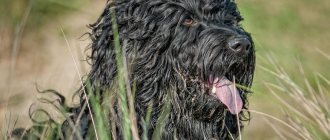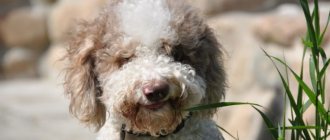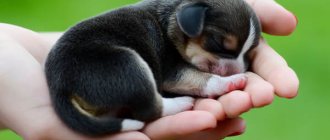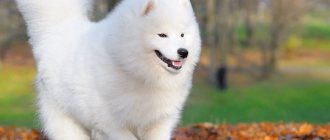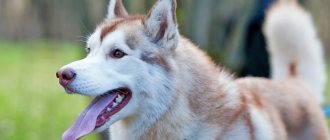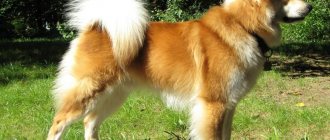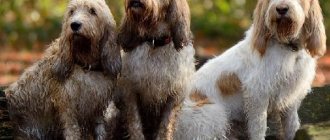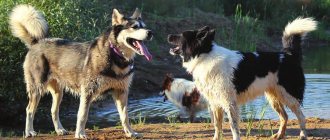Description of the breed
According to breed standards, Portuguese Water Dogs are medium in size. The height of males is 50-57 centimeters, females are slightly smaller - from 43 to 52 centimeters. The weight of individuals is from 19 to 25 and from 16 to 22 kilograms, respectively.
As for the body type, it can be different. The influence is exerted by the diet of animals and their lifestyle. The best option is if the pets have the conditions for active development and regular swimming. This allows you to develop muscles, form a skeleton and tighten the body.
The head of the “Portuguese” is wide and tapers towards the nose. The eyes are large, round, brown or darker in color, and have no light areas.
The body resembles a square, since its length almost corresponds to the height of the animal.
Girls have a more elongated body. The neck is strong and muscular. A neat tail can be curled into a half ring.
What makes the Portuguese Water Dog special is its coat. It is very dense and thick, without undercoat. The hair on the chest, front legs and groin is softer. Based on appearance, representatives of the breed are divided into 2 types. In the first case, they have curly hair, in the second - flowing wavy. Any other option is considered a marriage.
These animals also have several types of colors. The Wasserhund can have a pure black coat or white with brown spots. There are also individuals that have black or brown fur interspersed with white hairs. It is acceptable for a dog to be pure white, but it must not be an albino.
Purpose of the breed
This breed was bred to help Portuguese fishermen. The work involved the versatile use of dogs. On land, they guarded boats with catch and fishing gear. While in the boat, thanks to their subtle sense, they recognized the location of a school of fish and notified the owner that it was time to cast the nets. In the water, the dogs helped drive in fish and pull out gear, monitoring communication between boats, and also kept in touch with the shore.
Modernization of the fishing industry put Portuguese dogs out of work, and their popularity as working dogs almost completely faded in the first half of the 20th century. In 1970, there were only 50 representatives of the breed in the world, but by 2008, thanks to the intensive popularization of the Portuguese, the number of dogs grew to 10 thousand.
These are dogs with a high level of temperament and sociability with humans . Portuguese dogs really need communication, so dogs make wonderful companions, conversationalists and just friends, especially if the owner leads an active lifestyle.
The Portuguese water character is multifaceted, combining diametrically opposed qualities:
- intelligence coupled with willfulness;
- devotion with caution;
- discipline with childishness;
- love of freedom with love for the owner.
History of the breed
Scientists do not know for certain where this breed came from, but one of the historical novels says that the Romans bred this breed and called it lion because of its voluminous coat and strong character.
They got their name after they began to be actively used in fishing villages and in the navy.
Their lack of fear of water made them excellent helpers. They professionally jumped into the water after fish that dared to swim to the surface, and often emerged victorious in the fight.
They were also used on ships to quickly deliver letters from one ship to another. There are also cases where a Portuguese Water Dog, trained as a puppy, was sold for big money to large warships, or rented out.
Unsurpassed swimming skills and a flexible mind allowed the pet to easily return to its owner.
After the onset of the Industrial Revolution, dogs were no longer needed, and they almost became extinct. Only thanks to the efforts of lovers of camp customs and ways of life, it was possible to continue breeding.
Origin
The Wasserhund breed originates in Portugal in ancient times. However, there is no scientifically substantiated evidence of this fact. One theory says that representatives of the breed were brought by the Persians back in the 6th century BC. But the formation of the appearance and main characteristics, according to scientists, was completed in the Middle Ages.
After this, the “Portuguese” firmly established themselves on the coast. Their original function was to help local residents in fishing, which the dogs did very well. They could drive fish into nets, transmit messages from land to ships located in the fishing zone, and back. Accordingly, this required endurance and high performance; these qualities have been preserved among representatives of the breed in our time.
With the advent of the 20th century, industry and agriculture began to actively develop in Portugal. This could not but have an impact on the breed, which ceased to be in demand and almost found itself on the verge of extinction. However, dog handler Vasco Bensuade took up the problem. By the mid-20th century, Portuguese water dogs were sent to the British Isles, but the plan failed.
The breed was revived already in the 90s, when it was included in the registry of the American Kennel Club. After that, other countries around the world became interested in her, and now the puppies are quite in demand and have a decent price.
Origin story
These dogs began to be called water dogs because of the special properties of their coat to repel liquid and not get wet. They first appeared in Portugal many centuries ago. For a long time, this breed was isolated from the outside world, bred and used only in this country. It was most popular among sailors and fishermen.
A fast and dexterous dog, absolutely not afraid of water, helped people catch fish , driving them into nets and catching them right in their teeth. Also, sea vessels used such a dog to send messages to land and back. Later, the Portuguese Water Dog began to spread over land, where it showed excellent hunting abilities.
This dog left the borders of its homeland for the first time in 1958, when an exchange of rare breeds took place between Portugal and the United States. The Americans highly appreciated this dog and began to improve and breed it. The breed was first introduced to the world in 1983 as a working breed - hunting and fishing. After this, Portuguese water dogs began to spread to other countries.
Character
Dogs have an excellent sense of smell; it is not a problem for them to find the right thing even over a large area. Moreover, intelligence and intelligence help to observe the situation, evaluate it and, if necessary, decide to intervene.
Dog breeders believe that the Portuguese Water Dog is not inferior in development to breeds such as the German or Scottish Shepherd. However, this does not always work in favor of the hosts.
It is necessary to take care of the pet and give it maximum attention; in the absence of this condition, the animal will begin to get bored, and the lack of upbringing will manifest itself in the fact that it will be stubborn, spoil things and do dirty tricks in all available ways.
Despite the fact that representatives of this breed are very independent, this does not prevent them from being extremely loyal to their owners. Whether the pet will be obedient depends only on upbringing. He is very attached to all members of the family in which he lives, he also treats guests at home kindly, and is happy to make contact with them. It can indulge, but not out of malice, but because of its obstinate disposition, and tries not to upset the owner.
However, with all of the above, the Wasserhund is a serious breed. When raising children, you should follow some recommendations. The ideal option would be if the pet takes the position of a real family member, among which it most often chooses one owner. Such animals are very sociable; usually keeping them with other pets does not cause problems. The “Portuguese” will be an excellent companion for children and will be kind to older people.
In addition, such dogs are able to cheer up with just their appearance and irrepressible energy.
Experts advise getting them for people prone to frequent mood swings and depression. In European countries, dogs of this breed have proven themselves to be excellent companions; they are often worked with in psychological centers. The dog knows how to calm patients and put them in a positive mood.
Features of the breed and character of the Portuguese Water Dog
In photos, the Portuguese Water Dog often looks like a poodle. Their similarity is not limited only to external impressions - just like the poodle, the water dog has soft, non-shedding, water-repellent, odorless hair, an even, cheerful character, ease of training and tirelessness.
The breed is also distinguished by very good health and high resistance to stress, not to mention the fact that water dogs easily adapt to absolutely any living conditions.
The breed of dog is the Portuguese Water Dog , this is the only breed that, in addition to hunting “under guns,” was used until the mid-19th century by professional fishermen to drive schools of fish into nets, that is, in other words, for more effective fishing.
The abundance of fish in the markets not only of the Portuguese coast, but also of the coastal cities of France, Spain, northern Africa and others, was largely ensured by these dogs.
They were kept on fairly large fishing schooners, which went fishing all the way to the coast of Iceland, in search of large schools of cod and other fish.
Thanks to such raids, a breed appeared in Britain - the Irish water spaniel, which was descended from crossing Portuguese water spaniels with local varieties of spaniels.
The breed almost disappeared by the beginning of the 20th century, and would have sunk into history if Vasco Bensuade, a descendant of a fishing dynasty, a major magnate and practically a monopolist of the fishing industry in Portugal at that time, had not taken up the task of preserving and popularizing animals in 1930, thanks to with which his ancestors made very large capital.
The war somewhat delayed Vasco Bensuade's plans, and official world breed standards, as well as the very existence of this breed, were approved only in 1954. However, the dogs did not become particularly popular due to their external resemblance to poodles.
Previously, Portuguese water dogs carried information from ship to ship
The breed found its second wind in the USA, where it was included in the register of working dog breeds in 1983, and in 1984 the first Portuguese water dog kennel , located outside of Portugal itself, appeared in the States.
Today, the USA is a country where these dogs are very popular, and their breeding is in great demand. Portuguese merman are the pets of many American businessmen and politicians; for example, the former president of the country, Barack Obama, is among the fans of this breed.
Description of the Portuguese Water Dog breed (standard requirements)
The regulations regarding the standards of this breed have remained unchanged since they were approved in Britain in 1954. The main requirements for the standard relate to two parameters - height and weight. These indicators must correspond to the following values:
- height - from 50 cm to 60 cm for males, and from 40 to 53 for females; - weight - from 20 kg to 25 kg for males, and from 15 kg to 22 kg for females.
The remaining requirements are of a general nature - animals must have strong, pronounced muscles, have a lean appearance, fit into a “square” and be covered with lush, beautiful hair. Any color is allowed, the tail can be thrown over the back in a state of excitement.
The Portuguese Water Dog is often cut like a lion.
In the early 90s there was a time when attempts were made to make changes to the requirements for the standard regarding the color of dogs. It was supposed to be limited to black and brown, with white markings allowed, but these restrictions were not accepted.
The reasons for disqualification, both in the ring and in breeding for this breed, are: - pink spots on the skin, lips, nose, inside the mouth; - lack of proportional “square” outlines; - sagged in the line of the back.
Also, in European countries, albinos are culled at exhibitions, but in Asia and the USA, albinos are not disqualified.
Education and training
“Portuguese” are active and inquisitive dogs, so they are happy to learn something new. But if they don’t like the training methods, they will definitely show their character. This is why dog experts recommend starting training soon after the puppy arrives in the house.
Greyhound (dog): description of the English greyhound breed
It is a misconception that puppies do not perceive the flow of information. In fact, already at 2 months the dog is able to perform a set of basic commands. Early socialization will also allow the pet to understand how to behave correctly in society. This requires taking the dog out for walks regularly among people and other animals.
Note! It is advisable that the puppy communicate as much as possible with well-bred dogs of its own kind, ideally of its own breed.
To conduct specialized training, you will definitely need to consult an experienced dog handler. It is recommended to begin serious training from 6 months; at this age, the water dog is already intelligent, smart, assiduous and incredibly smart.
It is necessary to first draw up a set of creative and creative tasks aimed at developing physical skills and developing intelligence.
Dog care
The coat of this breed grows slowly and shedding is not very pronounced. You need to regularly comb your hair with a soft brush, removing old hairs. This will prevent the formation of tangles.
The Spanish dog's coat is not prone to accumulating unpleasant odors, so it does not need frequent washing. Water procedures can be performed 2-3 times a year. To protect your pet's hair from moisture and dirt in bad weather, you should wear overalls. At the same time, the dog loves water very much, and if he has a desire to swim in the summer heat, he should be allowed to do so. After this, you need to wipe your pet with a towel.
The dog's long hair requires regular haircuts. If the dog does not participate in exhibitions, the hairstyle can be anything. If the pet is a participant in such events, then there are two haircut options - “Lion” and “Working”. The first option involves maximum shortening of the hairs on the back and middle parts of the body and muzzle. The head, neck, chest and tip of the tail remain intact. A “working” haircut involves shortening the bangs to a length that does not interfere with the dog’s vision. The fur throughout the body is trimmed evenly, and only the tip of the tail remains with long hairs.
Dog eye and ear hygiene should be done daily. For this purpose, you need to use cotton pads soaked in boiled water.
The teeth of representatives of the water breed are strong and healthy. However, you should not neglect regular mouth examinations at the veterinarian’s office. Teeth may become coated with plaque, and in this case you cannot do without a special brush.
In the summer, it is necessary to protect your pet from parasitic insects by putting a special collar on it. Also, do not forget about regular deworming.
How to feed?
The basis of your pet’s diet should be premium food or natural products. In the first case, the pet will not need additional vitamin and mineral complexes, and when eating natural products, you will have to take care of artificially enriching the products with useful substances.
Representatives of this breed spend a lot of energy during the day, so half of their diet should consist of protein foods. For meat, it is better to give preference to boiled beef, game, and chicken. Fermented milk products should be presented in the form of cottage cheese and cheese. The diet should also be supplemented with eggs, cereals, stewed vegetables and a small amount of seafood.
The dog needs to receive 3-4 servings of food per day. The amount of food consumed at one time should be small to avoid gastrointestinal problems.
Health, life expectancy
The lifespan of such a dog is approximately 12 years. The health of representatives of this breed is very good. The pet's body has good immunity in the absence of most hereditary diseases. At the same time, the Portuguese have weaknesses:
- teeth;
- ears;
- gastrointestinal tract.
With proper care and regular visits to the veterinary clinic, health problems can be avoided. If the owner is breeding the breed, it is necessary to take tests for genetic eye diseases and hip dysplasia in the animal. At the same time, do not forget about preventive vaccinations against infectious diseases.
For your pet to have good physical and mental health, it needs long daily walks. It’s good if the dog lives in the courtyard of a private house: there it can spend its energy to the fullest. If the dog lives in an apartment, he will behave calmly only if he spends enough time outside.
In addition, the Portuguese do not like to be alone, so you should not leave them alone for a long time. Otherwise, the dog will become aggressive and embittered.
Care and maintenance
Portuguese Water Dog puppies require not so much care as they require exercise and training. This breed is not only very easy to train and is able to learn anything, but it is also incapable of living a full life without training.
A Portuguese merman will never lie quietly on a rug and pretend that she is a piece of furniture. These animals are created for work and strive in every possible way to find it, with all possible energy and enthusiasm.
In the absence of training or training in any activity, which is subsequently regularly used, deep psychological problems may develop, which will outwardly manifest themselves as follows:
— emotional passivity appears, the animal looks at one point for a long time, as if lost in thought, or begins to hide, while it is, of course, completely healthy physiologically;
- the dog begins to growl and snarl when attempting physical contact with it, including attempts to stroke or snap the leash carabiner;
- the animal becomes indifferent to its territory, it stops “going around on patrol” and responding to doorbells;
- the dog stops responding, although it does not run away, it seems that the dog simply does not hear that his name is being called;
- may suddenly start chasing other animals, cyclists and even cars.
Therefore, the main point of caring for and maintaining this breed is the ability and desire to work with the animal and provide it with workloads.
It is this quality that makes Portuguese water dogs one of the best dogs for a child of ten years and older - the animal will become an ideal companion, enthusiastically taking part in any fun and learning any tricks and “circus” acts.
In addition to training, the dog needs physical activity, the most ideal option is swimming. At the same time, you need to be prepared for the fact that the animal will drive ducks to the shore or force the otter to get out onto land at the owner’s feet if it swims in the conditions of lakes and rivers in the middle zone.
As for the coat, caring for it is the same as caring for a poodle’s “fur coat” - that is, you need to comb, cut and, if desired, decorate with hairpins and bows. Portuguese merman not only calmly accept all manipulations with their appearance, they love them very much.
What to look for when choosing a puppy, which nursery to buy from and what is the price
The breed is very rare, therefore, if you purchase a puppy without documents, there is a high probability that it will eventually grow up to be a mongrel or a mixed breed. Of course, they can also be true and devoted friends, but this fact will be unpleasant.
The cost of a puppy ranges from 70-200 thousand rubles.
Important! When choosing a puppy, you should pay attention to its age, behavioral characteristics and external characteristics. It would also be a good idea to get to know the puppy’s parents.
The Portuguese Water Dog is extremely rare, making it difficult to acquire. In nurseries you can wait for your turn for more than one month. But the acquisition of such a puppy will forever change the life of the household, she will become more active and always positive.
Price
Buying a Portuguese Water Dog will not be a cheap pleasure; the price of a Portuguese Water Dog reaches 200,000 rubles.
And the question “where to buy a Portuguese water dog” is difficult to solve. Outside of the US, it is quite difficult to find a purebred puppy.
Sources
- https://vplate.ru/sobaki/portugalskaya-vodyanaya/
- https://cesarsway.ru/poroda-portugalskaya-vodyanaya-sobaka.html
- https://DogGav.ru/porody/krupnye/portugalskaya-vodyanaya-sobaka.html
- https://mirsobaki.ru/portugalskaya-vodyanaya-sobaka/
- https://gafki.ru/sobaki/portugalskaya-vodyanaya.html
- https://zeleniymir.org/portugalskaya-vodyanaya-sobaka/
[collapse]
Advantages and disadvantages
The biggest positive quality of a dog is its temperament. A playful, active, always positive dog quickly becomes a loyal and devoted friend. Representatives of the breed get along well with children, but here the Portuguese Water Dog acts as a friend, and not as a nanny, participating in all the children’s games.
Deprived at the genetic level of aggression directed towards humans , dogs are not averse to chasing other domestic animals. But this looks more like a tough game than a pursuit with the aim of destruction. This character trait is corrected by education.
The disadvantages include the animal's waterproof, dense fur. Heavy rain cannot harm the dog, but the Portuguese dog cannot withstand strong frost and, as a rule, becomes seriously ill. And given the secrecy of character, a severe cold may not be immediately noticed, and this can end very sadly.
Natalia:
For our wedding anniversary, my husband gave us a gift - he brought a puppy from Germany. Curly, black with white spots, in short, classic. My disappointment knew no bounds; I so wanted a dog with straight, long hair. Until I talked to the girl, she immediately took me for the hostess. Now I simply cannot imagine my life without her. I ordered a male dog from the kennel so that she could have a mate.
Marina:
The breed is smart and sensible. Simply an amazing creation. The attitude towards children is beyond praise. My male dog runs around with the child in such a way that I am sometimes surprised by his tenderness and agility, and at the same time great care in handling the baby.
